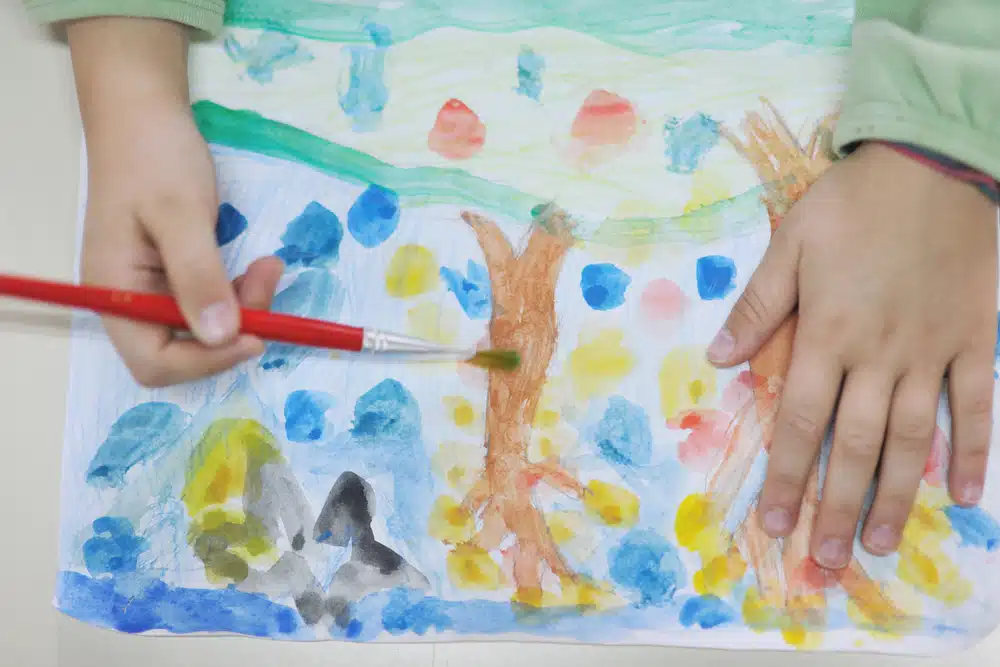Many people view art as a fun activity for children to pass the time. However, artistic endeavors are a crucial part of early childhood development (ECD) and play an important role in fueling creativity and educational achievement. Art stimulates children’s minds and has several notable tangible benefits in terms of education and socialization. With that in mind, the team at Bubbles Academy is here to discuss unlocking your child’s potential through art.
Planting the Seeds of Creativity: Why Art Matters in Early Childhood
When children are developing in their early years, they are naturally curious—anyone who has withstood the onslaught of a toddler asking “why?” to every answer knows that much. This curious exploration is crucial for developing real-world problem-solving skills and learning how to interact with their environments.
Artistic activities feed this natural inclination into a tangible project. Art allows children to manipulate different mediums and combine concepts through free-form exploration and association. Not only does art stimulate creative activity, but it also teaches children about self-exploration and direction—skills that are incredibly useful at all stages of life.
A Palette of Benefits: How Art Enhances Early Childhood Development
Art is more than just play-based learning. It also has tangible neurological, cognitive, and social benefits. Below are just child development skills that art can foster.
Fine Motor Skills
At a basic level, manipulating artistic materials, such as paints, pencils, crayons, etc., trains fine motor development in young children. The motor skills children learn while experimenting with art transfer to other areas, such as tying their shoes or buttoning a coat.
More specifically, studies have shown that artistic exercises enhance children’s motor coordination, reaction times, manual dexterity, and selective attention.
Language Comprehension
Part of creating art is using language to describe concepts. In that sense, artistic exploration enhances language comprehension and proficiency. Not only does art engage the conceptual areas of our brain that relate to language use and acquisition, but art gives children an opportunity to expand their vocab, whether it’s through artistic terms (e.g., texture) or through describing the subjects of their work.
Mathematical Ability
Although not explicit, art can also introduce children to various mathematical concepts and techniques, such as shape, size, proportions, and general spatial reasoning. Artistic exploration trains pattern-recognition faculties, including non-visual artistic mediums, such as music.
One study in the journal Psychology of Aesthetics, Creativity, and the Arts found that children who develop spatial reasoning abilities through visual artistic practice perform better on mathematical and geometrical reasoning assignments than disadvantaged children. Other studies have found that musical activity in children can enhance basic mathematical abilities, such as arithmetic and detecting symmetry patterns.
General Cognitive Development
The open nature of artistic expression is more conducive to the development of task-neutral cognitive capacities and is better for enhancing executive functioning. For example, art can teach children about cause-and-effect relationships and also train their ability to create and see through mental plans for art projects. Also, group artistic projects help children socialize and teach them the importance of working with others toward a common goal.
Self-Esteem
Perhaps most importantly, artistic projects promote self-confidence and a desire to learn. Several studies have shown that self-esteem is positively correlated with academic achievement in children and adolescents.
What Is More Important To Children’s Development: The Process Or The Product Of Art Making?
This answer can be complicated because BOTH can be important to creating healthy individuals however, to help children develop their Creative Confidence FIRST focus on the process.
Process Art Making is an open-ended and self-driven art experience that focuses on understanding, creating, and exploring different kinds of materials, tools, and techniques. In a process driven and open-ended art making activity there are NOT step-by-step instructions, create anything!
Children engage in process art because they are self-motivated to create because of the sensory, emotional, and playful experience art provides them. Children start out exploring the art materials to better understand and interact with their world, gain independence, develop fine motor skills, foster self-confidence and in time, children will begin to value the product but, in the meantime, LET THEM CREATE!
Key Factors
- DON’T be afraid of mess
- Allow for the exploration of LOTS of materials
- DON’T worry about “What is it?”
- There isn’t a right or wrong way to create/make something
- Hang up the child’s work for display – they will feel proud
Inspiring Activities: Fueling the Creative Fire
The key to stoking a child’s artistic curiosity is finding a wide range of projects and activities to engage in. Below are some inspiring activities children can take part in to facilitate quality early childhood development.
Drawing
Drawing is a basic artistic activity that teaches children about fine motor control and mediating 2D representations of 3D space. Drawing also teaches important lessons about perspective, shapes, and symbolism.
Sculpting
Sculpting projects like clay and pottery are great for teaching manual dexterity and hand-eye coordination. You can ask children to create a specific object or give them free rein to create whatever sculptures they want.
Collages
One fun activity for children is creating collages of different materials. Collages engage freeform association by having children group together images or items that relate to a specific concept. For example, children can be asked to create a collage of things that remind them of their family or create a collage of things that focus on their favorite color.
Mixing Colors
Colors have a significant effect on human emotions and cognitions, and even babies as young as five months old can distinguish between different basic shades, such as red and green. Color-focused activities, like paint mixing, reinforce color perception and help understand the relationship between different pigments on the color wheel. Color exercise also assists children with emotional regulation and helps teach them how to navigate their environments.
Puzzles
Puzzles are excellent for pattern/shape recognition and short-term memory. Children need to be able to visualize the completed image when assembling the pieces, so the activity teaches them to concentrate and think logically.
How Can I Encourage and Nurture Creativity—A Toolbox for Parents and Teachers
Below are some additional tips for how parents and teachers can create a strong foundation for early learning and artistic exploration.
- Introduce various types of artistic projects, including visual art and music. Combining artistic activities is even better.
- Don’t focus so much on the finished product. The point of art for early childhood development in preschool is to freely explore creativity and concept association, not create a specific piece of art.
- Don’t micromanage children’s art projects. Let them freely explore materials while you offer guidance. Interfering with their art robs them of feeling self-accomplishment.
- Parent participation is an important part of keeping children motivated and engaging their creative faculties. Parents should set aside specific times to play art and get creative with their children together.
Cultivating a Lifelong Love of Learning
Taking an active role in early childhood development is the key to setting your child up for long-term success. Contact Bubbles Academy online or call today at (312) 944-7677 to register your child for a free trial class!

